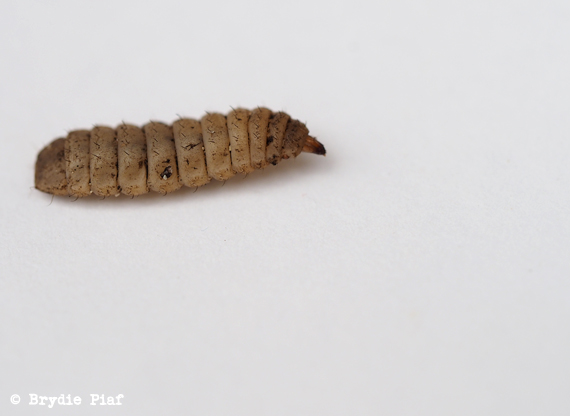They are incredible composters, excellent sources of protein, extremely polite by self harvesting themselves and might just be the alternate meat source that world wide dinner circles need to embrace. Say hello to the Black Soldier Fly.
Now the title of this post doesn’t even particularly make sense but hey, it was that or March of the Soldier Fly…actually, on reflection the later was probably a better choice.
The long story of how I came to have a compost bin with a seething wriggling mass of maggots, requires a pot of tea, shoes left at the front door and no place to be for an hour or more, (or something like that.)
The short version was, what started as a small maggot problem with questionable outcomes, turns out is an excellent compost larvae friend of which I have inadvertently created a home for and is now looked upon as some prime utopian real estate for soldier fly larvae.
Seriously, it really is the promised land for wriggly segmented critters.
Now before I disgust some of you any further, and you click off for good let’s quickly recap on why these (quite incredible) critters are good for your compost, (and also why you should just skip to the acceptance and embracing stage of having them in your garden/compost/table and simply bypass the revulsion and dry gagging bit that I had to go through first. I mean really, just skip that bit, these guys are awesome.
- Black Soldier Fly are about half the size of a regular house fly, they also naturally keep away house flies- and that dear people is a good thing.
- They don’t mind it hot, actually the hotter the better. Anything upwards of 27C is going to show activity and humidity is apparently a big factor. Being in a black compost bin with the weather we’ve been having lately (rain++ and hot++) I’d say has had a big impact on their numbers.
- They are excellent composters due to playing a big part in contributing with decomposition and nutrient cycles. They are also rather excellent at aiding the bioconversion of organic waste material.
- They are a great form of protein. I’m not ready to get in there for that dinner plate just yet, but for animal feed, herptiles and tropical fish I say buon appetito.
- If you were keen on cooking up a little spagetti alle larvae, have a peek at this site, Farm 432. It’s a table top incubator essentially where you grow your own sustainable protein filled dinner.
- Protein wise they are filled with in terms of % and in comparison with their other insect counterparts, they are definitely front runners.
- They clean themselves just before they self harvest, plopping right over the side, ready to be scooped up.
- They are only dark in colour at the very end of their pupation, I had previously seen them like that so had discounted mine as something else, as they were cream coloured, (rookie mistake.)
“…reduce the volume and weight of would-be waste: The larval colony breaks apart its food, churns it, and creates heat, increasing compost evaporation. Significant amounts are also converted to carbon dioxide respired by the grubs and symbiotic/mutualistic microorganisms.” (Wikipedia.)
Really, they are hoovering through the compost, considering mine is only weeks old and not as balanced as I would like it, the quality is pretty darn good. I’d say a good proportion of that is due to my wiggly segmented (creamy coloured) friends. (They can apparently reduce composts or manure down by 50-70%.)
Now I’m absolutely fascinated by these critters, having watched their behaviour over the last couple of weeks, not understanding what was happening, seeing them explode in population, and reading up a lot. I’ve gone from dry gagging to grinning excitedly and holding them in my hands.
And really, how exciting is learning something completely new eh.
*************
More fascinating reads found here.
And a huge thank you to my mate Sarah who introduced me to these critters in the first place.




